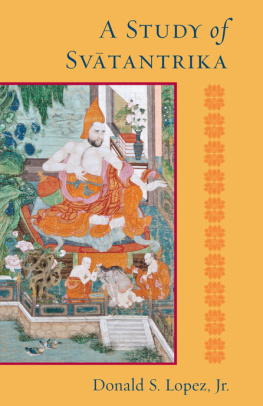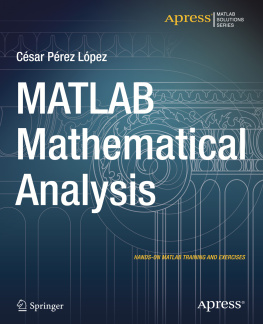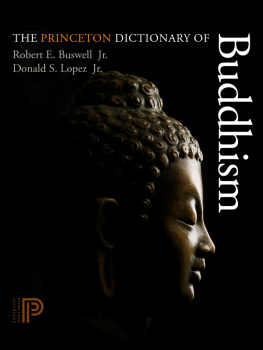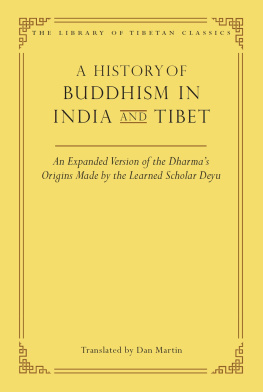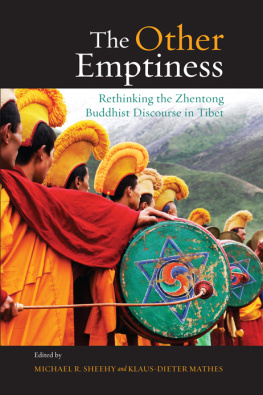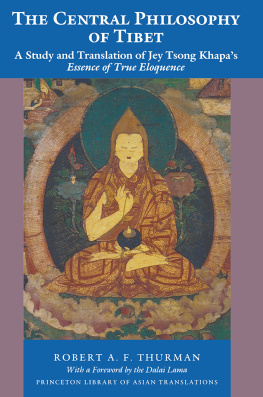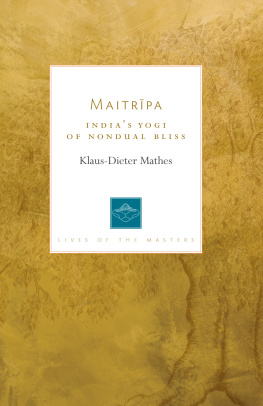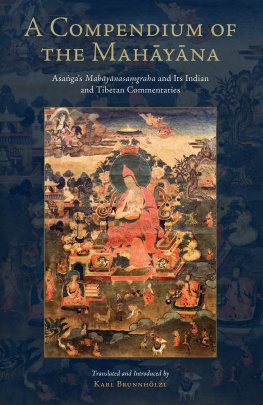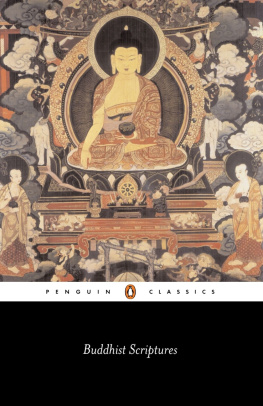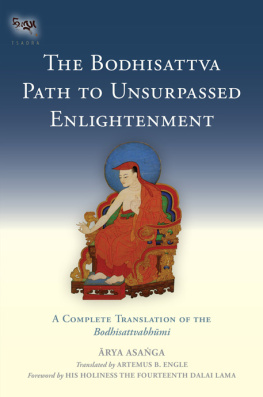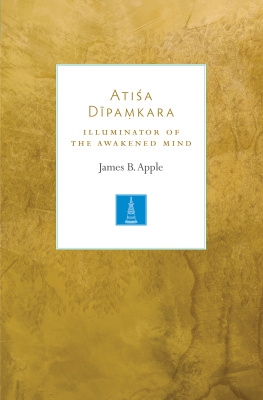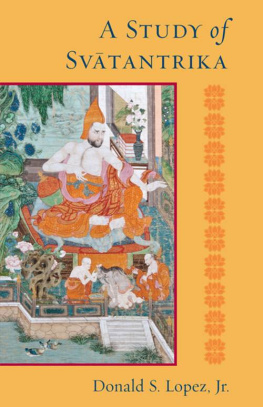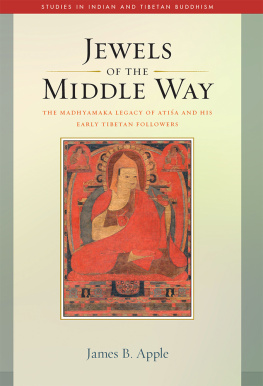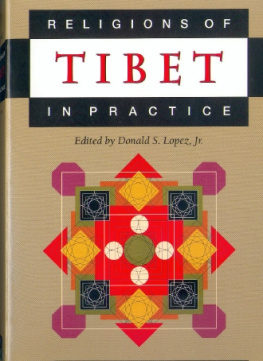ABOUT THE BOOK
Donald S. Lopez Jr. presents a clear and extensive picture of Svatantrika Madhyamika through analysis of issues and positions central to Indian philosophy during the final development of Buddhist thought in India. Central issues are considered: the division of Madhyamika into Svatantrika and Prasangika, the meaning of emptiness, the root cause of suffering, the division of objects of knowledge into the two truths, and the reasoning employed to refute the existence of a self. Included are overviews of Madhyamika in general and Svatantrika in particular.
DONALD S. LOPEZ JR. holds a PhD in Religious Studies from the University of Virginia, where he specialized in Tibetan Buddhism. As a Fulbright scholar in India, he studied Madhyamika philosophy with leading Tibetan scholars. After teaching in the Department of Religion at Middlebury College, he is now Chair of the Department of Asian Languages and Cultures at the University of Michigan. He is the author of numerous books on Buddhism and Tibet, including Elaborations on Emptiness and The Heart Sutra Explained.
Sign up to receive weekly Tibetan Dharma teachings and special offers from Shambhala Publications.

Or visit us online to sign up at shambhala.com/edharmaquotes.
A STUDY of SVTANTRIKA
Donald S. Lopez, Jr.
SNOW LION
Boulder 2016
Snow Lion
An imprint of Shambhala Publications, Inc.
4720 Walnut Street
Boulder, Colorado 80301
www.shambhala.com
COVER ART: Thangka of Acarya Bhvaviveka, artist unknown, 18th century. Used with permission from the Philadelphia Museum of Art. Gift of Natacha Rambova, 1959.
1987 by Donald S. Lopez, Jr.
All rights reserved. No part of this book may be reproduced in any form or by any means, electronic or mechanical, including photocopying, recording, or by any information storage and retrieval system, without permission in writing from the publisher.
Library of Congress Catalogue Number 86-14636
The Library of Congress catalogues the previous edition of this book as follows:
Lopez, Donald S., 1952
A study of Svtantrika.
Bibliography: p.
Includes index.
eISBN 978-1-5593-9751-3
ISBN 978-0-937938-20-1 (hardcover)
ISBN 978-0-937938-19-5 (paperback)
ISBN 978-1-55939-455-0 (2nd ed.)
1. Svtantrika. I. Title.
BQ7478.L67 1987
294.392
86-14636
This book contains diacritics and special characters. If you encounter difficulty displaying these characters, please set your e-reader device to publisher defaults (if available) or to an alternate font.
Dedicated
to
William Stone Weedon
1908-1984
My study of Svtantrika began in 1977 when I began reading Den-dar-hla-ram-bas (bsTan-dar-lha-ram-pa, born 1759) Presentation of the Lack of Being One or Many (gCig du bral gyi rnam gzhag). Finding it difficult to take full advantage of this text without a broader understanding of the Svtantrika school, I turned my attention to the Svtantrika chapter of Jam-yang-shay-bas (Jam-dbyangs-bzhad-pa, 1648-1721) Great Exposition of Tenets (Grub mtha chen mo). Intending to include this chapter as the translation section of my dissertation, I set out for India under the Fulbright-Hays Doctoral Dissertation Abroad Program. With the kind cooperation of my advisor, Dr. K. K. Mittal of Delhi University, and the assistance of C. S. Ramakrishnan, Director of the United States Educational Foundation in India, I soon left for Dharmsala and the Library of Tibetan Works and Archives, where I completed a rough translation of the Svtantrika chapter of the Great Exposition of Tenets, along with Nga-wang-bel-dens (Ngag-dbang-dpal-ldan, born 1797) invaluable Annotations (mChangrel). While in Dharmsala, I had the opportunity to study the root text of the Mdhyamika chapter of the Great Exposition of Tenets with Go-mang (sGo-mang) Geshe (dGe-bshes) Den-ba Gyel-tsen (bsTan-pa-rgyal-mtshan), later scholar-in-residence at Toyo Bunkyo in Japan. Upon returning to Delhi, I began classes with Geshe Bel-den Drak-ba (dPal-ldan-grags-pa), Librarian of Tibet House, who read with me the entire Svtantrika chapter of Jam-yang-shay-bas Great Exposition of Tenets. His skillful exposition kept me in Delhi longer than I had planned.
On a trip to Sarnath, I visited the Central Institute for Higher Tibetan Studies, where I was able to put the questions that were beginning to accumulate to two senior instructors of the Institute, Lo-sel-ling (bLo-gsal-gling) Geshe Ye-shay Tap-kay (Ye-shes-thaps-mkhas) and Go-mang Geshe Tsul-trim Gya-tso (Tshul-khrims-rgya-mtsho).
In January 1979, I made the first of two trips to the Ge-luk monasteries of Gan-den (dGa-ldan) and Dre-bung (Bras-spungs) in Karnataka State. There I was able to study the Great Exposition of Tenets with the abbot of Go-mang College, Nga-wang Nyi-ma (Ngag-dbang-nyi-ma). Realizing that at some point I should also read the Svtantrika chapter of Jang-gyas (lCang-skya-rol-pai-rdo-rje, 1717-1786) Presentation of Tenets (Grub pai mthai rnam par bzhag pa), I asked the former abbot of Lo-sel-ling College, Yeshe Thupten (Ye-shes-thub-brten), to read the text with me. His commentary proved captivating, and I soon decided that Jang-gyas chapter should form the translation section of my thesis. After returning to Dharmsala in April to attend public lectures by the Dalai Lama, I came once again to Dre-bung, where I began to translate Jang-gya. During this second visit I also studied the Yogcra and Svtantrika chapters of Tsong-kha-pas Essence of the Good Explanations (Legs bshad snying po) with Yeshe Thupten. I returned to the United States in August 1980. In 1981, I reviewed Bhvavivekas refutation of Yogcra in Jang-gyas chapter with the former abbot of the Tantric College of Lower Lhasa and present holder of the throne of Gan-den (dGaldan khri pa), Jam-bel Shen-pen (Jam-dpal-gzhan-phan).
I wish to express my appreciation to all of the scholars mentioned above. Their insights into the world of Buddhist philosophy are the reward to those who learn to speak Tibetan. In addition, I offer my deep thanks to His Holiness the Dalai Lama, who offered penetrating answers to my most difficult questions in audiences in Dharmsala, Montreal, and at Harvard University. Finally, I wish to thank my thesis advisor and mentor, Professor Jeffrey Hopkins, for all of his help and encouragement during my research, both in India and the United States. It is often the case that after studying with one person for an extended period of time we sadly reach the end of his or her learning. This has not been my experience with Professor Hopkins.
The transliteration systems for Tibetan words is that devised by Turrell Wylie is used. This adaptation of the Hopkins system facilitates accurate pronounciation of the Lhasan dialect and is used throughout the text wherever Tibetan names occur. Tonal markers above consonants that are used in the Hopkins system have been omitted in the body of this text.
The conversion table from transliteration to phonetics is as follows, with the transliterated form on the left of each column and the phonetic form on the right. Lines above letters indicate that the tone is high, with a sharp and short pronunciation:

The phonetic system is derived by using the phonetic columns above and substituting
Next page
